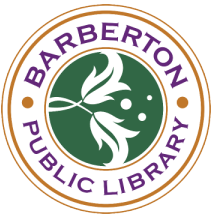
History of the Library
The Library has been open in Barberton since 1903. Over the course of the Library’s life, many things have evolved and changed. Find out more about the Library’s history in Barberton that brought us to today!
Beginning
On April 7, 1903, the Barber Public Library opened in a room on the second floor of the Whigam-Schubert building. The Library collection included 2,400 volumes donated by O.C. Barber, and an additional 1,000 volumes purchased by the City and donated by friends. The initial idea for the Library was created by a girls group led by Minnie Cassell Johnston. The group raised $1,000 with donations from community members and businesses. Mary Taplin was hired as the first Librarian. The Barber Public Library was dedicated to the citizens of Barberton on Friday, July 18, 1902.
Library Grows
By the early 1920s, the Library outgrew the rented rooms on the second floor of the Whigam-Schubert building. In 1922, the Library moved to the rooms above City Hall. Again, in May 1925, the Library outgrew the rooms and moved to the ground floor of the Masonic Temple. In 1926, AO Austin donated the remaining books in the Barber Mansion to the Library.
Expansion Continues
In 1947, the name was changed to Barberton Public Library. By the 1950s, the basement of the Temple was no longer big enough and there was a desire to separate adult and children’s departments. On October 16, 1957, the Library’s move to 602 West Park Avenue began. The move took 6 days to move all 40,000 books and equipment.
The Friends of the Library were established in 1971.
In 1976, Barbara Kirbawy became the director and added public use computers. Construction on the Library building began in 1985, and completed in 1986. In 2002, the Community Health Branch Library opened. Julianne Bedel became director in 2007. Two quiet study rooms were built in 2015.
The Current Age
In 2016, the Library needed another expansion to adapt to the needs of the community. Ann Hutchison became director in 2019. COVID made the Library adapt to offer online programming and curbside services. In 2019, the Library proudly became fine-free.
In 2024, the Library began remodeling the basement, launched the Library of Things collection, and began the process of renovating the Main Floor.
